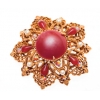|
 Filigree is
the openwork pattern or that soldered onto the metal base from the wire,
whether silver or gold, though gold wire is rarely used. The wire is
used as plain or twisted. The word «filigree» actually explains the technology
of pattern creation from the Latin word filum - thread and granum as a grain or
a corn. The technology describes the whole manufacturing procedure. Filigree is
easily recognized for the delicate pattern and for strands of metal threaded
into complex designs. This style of jewelry was far popular in the past though
it has become more rare and specialized throughout the years. Filigree is
the openwork pattern or that soldered onto the metal base from the wire,
whether silver or gold, though gold wire is rarely used. The wire is
used as plain or twisted. The word «filigree» actually explains the technology
of pattern creation from the Latin word filum - thread and granum as a grain or
a corn. The technology describes the whole manufacturing procedure. Filigree is
easily recognized for the delicate pattern and for strands of metal threaded
into complex designs. This style of jewelry was far popular in the past though
it has become more rare and specialized throughout the years.
The wonder
of the openwork filigree is known from the ancient times. The first filigree was
seen in Troy, Crete, Mycenae,
Egypt and Greece which
were made in the VI-IV centuries B.C. The filigree was acknowledged as one of
the basic and principal jewelry technologies. This is quite reasonable
since the pure precious metals, silver and gold, are known to be soft and the
technology is easy to make thin and delicate wires from these metals. In the
ancient time the rounded wire was achieved by forging and polishing of the
metal rod and since the Х century jewelers mastered the process of wire drawing.
The technology is difficult to create and finish by hand, so
the filigree jewelry was found to be incredibly demanded during the Art Deco
period of the 20's and 30's. Filigree comes as the soldered, laced and volumetric.
When the soldered filigree work is made from the plain or twisted wire and the
granulation is soldered to the sheet of metal. When the pattern is soldered onto the metal, such
filigree is called background or ground supported work. If the background is
removed after soldering with punching or sawing, then this is cutting-out or sawed
filigree. The filigree can be raised by embossing and here the pattern is
soldered onto the chased relief prepared. The most beautiful soldered filigree
is that with enamel or plique-a-jour. After the pattern is soldered onto
the metal, the open spaces are filled with enamel.
The open
work filigree can do without metal base, and here the wiring pattern is
soldered by itself, while the granulation is soldered onto the metal lace. If
the lace is flat and two-dimensional, we have the flat open work filigree. When
the lace is soldered in two dimensions and is volumetric (3-D relief or high
relief), then this is the sculptural raised open work filigree. Sometimes the openings
between the woven details are filled with the transparent enamel to create the
tiny colorful vitrage, and such work is called open work filigree with enamel
or enameled glass. Multidimensional filigree looks very attractive when the patterns
are laid one over another and the patterns are located in various planes which
results in the volumetric work from the flat one.
Three-dimensional
work is the item made by the twisting technology. So, this is the
technique used in making bowls, vases, trays, caskets and boxes including
various accessories with images of birds and animals as well as architecture
features. The relief filigree
is made in parts, and the parts are then mounted into the entire composition.
The filigree technique in Russia was used from the old
times. The church items, metal cover of icons and sacred books were decorated
with this work. The weapon and
furniture and expensive shoes from morocco fabric were also decorated in the filigree
patterns. There were special workshops which were busy in wire drawing
especially to cover the needs in wire for filigree works.
In 1917 the filigree art suspended though in the 20s of the ХХ
century the art was revived. The Russian filigree work was known to the world
and the work was like a signature of Russian jewelry art.
In 1937 the
works of artisans were exhibited in Paris to be
awarded a golden Medal and in 1939 New
York show rooms demonstrated Russian works. In
the 90s the art of filigree declined again. This art requires the slow but permanent and thoughtful approach and the
authentic filigree work is hand-made. Such a tender jewelry art cannot endure
any revolution stresses. Recently the work showed tendencies to rehabilitation
and the Russian filigree is worth living in the people not to be exposed as a
museum item.
|